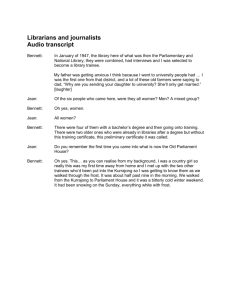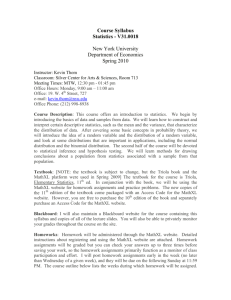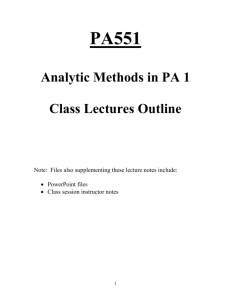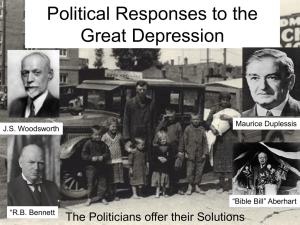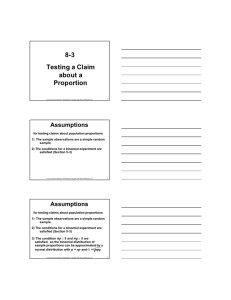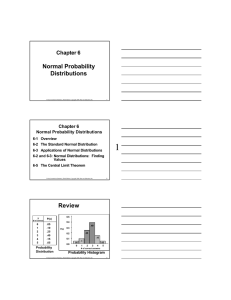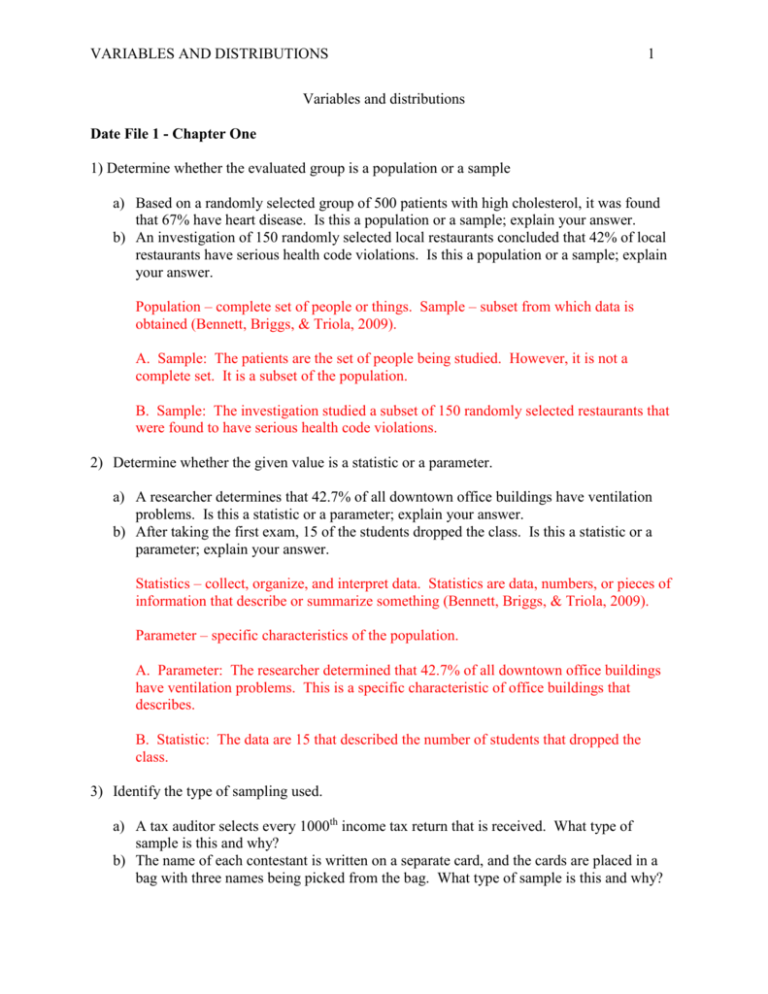
VARIABLES AND DISTRIBUTIONS
1
Variables and distributions
Date File 1 - Chapter One
1) Determine whether the evaluated group is a population or a sample
a) Based on a randomly selected group of 500 patients with high cholesterol, it was found
that 67% have heart disease. Is this a population or a sample; explain your answer.
b) An investigation of 150 randomly selected local restaurants concluded that 42% of local
restaurants have serious health code violations. Is this a population or a sample; explain
your answer.
Population – complete set of people or things. Sample – subset from which data is
obtained (Bennett, Briggs, & Triola, 2009).
A. Sample: The patients are the set of people being studied. However, it is not a
complete set. It is a subset of the population.
B. Sample: The investigation studied a subset of 150 randomly selected restaurants that
were found to have serious health code violations.
2) Determine whether the given value is a statistic or a parameter.
a) A researcher determines that 42.7% of all downtown office buildings have ventilation
problems. Is this a statistic or a parameter; explain your answer.
b) After taking the first exam, 15 of the students dropped the class. Is this a statistic or a
parameter; explain your answer.
Statistics – collect, organize, and interpret data. Statistics are data, numbers, or pieces of
information that describe or summarize something (Bennett, Briggs, & Triola, 2009).
Parameter – specific characteristics of the population.
A. Parameter: The researcher determined that 42.7% of all downtown office buildings
have ventilation problems. This is a specific characteristic of office buildings that
describes.
B. Statistic: The data are 15 that described the number of students that dropped the
class.
3) Identify the type of sampling used.
a) A tax auditor selects every 1000th income tax return that is received. What type of
sample is this and why?
b) The name of each contestant is written on a separate card, and the cards are placed in a
bag with three names being picked from the bag. What type of sample is this and why?
Sampling methods – random sample, simple random sampling, systematic sampling,
convenience sample, stratified sampling, and cluster sampling (Bennett, Briggs, & Triola,
2009).
A. This is a systematic sampling method. This method chose every 1000th income tax
return that was received. There is no reason to believe that every 1000th income tax
return has any special characteristic compared to other income tax returns.
B. This is a simple random sampling method. The sample is chosen in such a way that
each contestant has an equal chance of being selected as long as each contestant's name is
in the bag only once.
4) Is the study experimental or observation and why?
a) A political pollster reports that his candidate has a 10% lead in the polls with 10%
undecided.
Observational study – observe or measure the characteristics of the subjects.
Experimental apply some treatment and observe the effects on the subjects (Bennett,
Briggs, & Triola, 2009).
This study is an observational study. The political pollster reports on the specific
characteristics of his candidate that he observes or measures: 10% lead in the polls with
10% undecided. There is no evidence that the pollster influences or modifies the specific
characteristics.
5) Select the study that is most appropriate and EXPLAIN WHY it is most appropriate for the
study.
a) Is the aspirin produced by a particular pharmaceutical company better than that of a
competitor at relieving headaches? Which of the following would best be used to study
this: 1) a case-controlled observation; 2) an observation; 3) a double-blind experimental
procedure; and 4) and experimental procedure.
Observational studies look at past data or future data over a long period of time. Double
blind study is if neither the participant nor the experimenter knows who belongs to the
treatment group or who belongs in the control groups. The experimental procedure
somehow influences the subjects. Case control or retrospective use data from the past
(Bennett, Briggs, & Triola, 2009).
A. The most appropriate study is the double blind study. Neither the participant nor the
experimenter would know who belongs to the treatment group or control group. If one
group was given an aspirin produced by a particular pharmaceutical company and another
by its competitor the study would be fair and reasonable versus experimental where
somehow the study would be influenced.
From Chapter One
VARIABLES AND DISTRIBUTIONS
3
1) Focus on Public Health—On page 51 and 52 of the text, it discusses the Harvard Nurses’
Health Study, which is a very well-known study that has been conducted for a number of
years. Answer discussion question two at the back of the article.
Explain why the Harvard Nurses’ Health Study is an observational study. Critics state
that the results would be more valid if obtained by experiments rather than observations.
Discuss whether it would be possible to gather similar data by carrying out experiments
in a practical and ethical way.
An observational study observes or measures specific characteristics while trying not to
influence or modify the characteristics that the study is observing. The purpose of an
experiment is to study the effects of some treatment (Bennett, Briggs, & Triola, 2009, p.
21). This professor decided to study the long term effects of an oral contraceptive by
mailing questionnaires to approximately 370,000 registered nurses. The professor
believed the nurse’s responses would be more reliable due to their medical training than
the general public. This method relied on honesty and integrity (Bennett, Briggs, &
Triola, 2009).
There may be additional experiments in the future that could be conducted this way,
however, not all experiments can be done this way using the method that this professor
did. When an experimenter sends out surveys there is always those, and in some cases, a
significant amount of surveys that will not be returned or properly completed. Surveys
may not be a fully controlled environment. The critics could be accurate as it pertains to
the data. Actual testing of selected or random participants may present more accurate
data and the subjects are observed. However, this type of study is very expensive and
time consuming. Whereas, a survey may be more cost effective depending on the
experimenter’s allotted budget for the study (Bennett, Briggs, & Triola, 2009).
Chapter Two
1) Identify the following variables as either qualitative or quantitative and EXPLAIN your
answers.
b) The number of people on a jury.
c) The color of your house
Qualitative consists of values that can be placed in non-numerical categories.
Quantitative are values that represent counts or measurements (Bennett, Briggs, & Triola,
2009).
A. The number of people on a jury is quantitative due to they can be counted and stated
as a number.
B. The color of your house is qualitative due to colors can be placed into categories.
Colors are not represented as numbers that can be summed or averaged.
2) Identify the number as either continuous or discrete and EXPLAIN your answers.
a. The average height of all freshmen entering college in a certain year is 68.4 inches.
b. The number of limbs on a 2-year-old oak tree is 21.
Continuous data can take on any value in a given interval. Discrete data can take on only
particular, distinct values, and no other values in between (Bennett, Briggs, & Triola,
2009).
A. This is continuous due to the height of freshman entering college each year will vary.
The data can take on values that are fractions or decimals as in the case of this average
height.
B. This is discrete. The number of limbs was counted and has distinct values with no
other values in between.
3) Determine which of the four levels of measurement is most appropriate and explain your
answer.
a. Temperatures in degrees Fahrenheit of the ocean at various depths.
b. The rank of individuals in the military
c. The number of people with blue, brown and red hair in a classroom
The four levels of measurement are: nominal, ordinal, interval, and ratio (Bennett,
Briggs, & Triola, 2009).
A. This is interval. Fahrenheit temperatures are at the interval level of measurement.
The zero point is arbitrary; it does not mean "no heat".
B. This is ordinal; qualitative data that can be arranged in some order. Rank has order
and chain of command but the differences between values are not constant.
C. This is nominal. The number of people with blue, brown, or red hair in a classroom is
quantitative which can then be represented as a number of people with blue, brown, or
red hair and is meaningful.
4) Determine the following (show your work):
a. The speed of a new microprocessor is 800MHZ, but a new test of its speed gives a
measurement of 820MHZ. What is the absolute error? What is the relative error?
b. Convert 1/16 to a percent
c. Convert 0.45 to a percent
d. Humanities majors spend an average of $115 per course on books. Mathematics majors
spend an average of $70 per course on books. What is the percent difference between the
two amounts relative to the amount for mathematics majors (round to the nearest
percent)?
e. Suppose that the cost of a statistics text was $50 in 1985 and is $100 in 2000. What is the
“Statistics Text Index” number, rounded to the nearest tenth, for the 2000 edition with the
1985 price as the reference value?
VARIABLES AND DISTRIBUTIONS
5
A.
The absolute error = measured value – true value
=
820MHZ - 800MHZ
=
20MHZ
The relative error = absolute error x 100%
true value
= 20MHZ
x
100%
800MHZ
= 2.5%
B.
Convert the common fraction to a decimal = 16 /100
= 0.0625
Convert the decimal to a percentage
= 0.0625 x 100
= 6.25%
Answer:
6.25%
C. 0.45 = 45%
D. $115 - $70 = $45
$45/$70 = 64% difference between math majors.
E. 100/50 x 100 = 200 statistics text index
From Chapter Two
2) Focus on Economics—On page 86 and 87, the article looks at an important issue to
everyone—the economy. In particular it is focusing on whether our standard of living is
improving. Answer discussion question one at the back of the article.
Based on the graph in figure 2.5, describe in general terms how real wages have changed over
the past three decades. For example, describe the general period in which wages have risen and
those in which wages have declined.
As inflation rises, if a person’s income level does not increase, the standard of living will
decrease. A person may pay out more in expenses than they have coming in as income.
Especially, if a person has new unexpected expenses coming in that were not anticipated.
For many families, this may occur more frequently than not. Expenses such as groceries,
gas, and personal products are continuously rising. On average, an employee’s wage is
not increasing as expenses increase. The employee typically has to make concessions
and eliminate non-essential items.
There are various driving forces that can change the economy and wages, along with
various opinions on how and why this occurs. As the economy changes, supply and
demand changes, these all have an effect on standards of living and wage increases or
decreases. Even with small cost of living increases, may not help as gross domestic
products change. Real wages have changed over the past three decades as major factors,
life changes, and the economy have changed. Some factors have been positive, while a
majority such as increase in gas prices has been a negative factor in today’s economy.
The average person may feel that real wages have not increased since people seem to
have more and more out of pocket expenses and less in savings (Bennett, Briggs, &
Triola, 2009).
VARIABLES AND DISTRIBUTIONS
7
References
Bennett, J. O., Briggs, W. L., & Triola, M. F. (2009). Statistical reasoning (3rd ed.). Boston,
MA: Pearson Addison Wesley.

